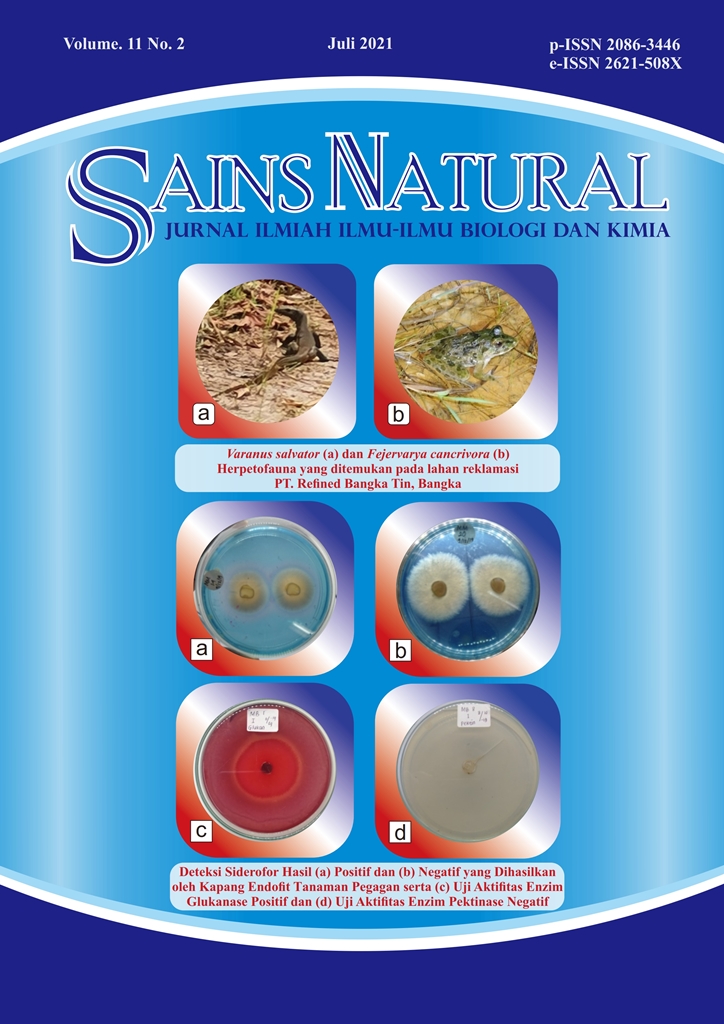Inventory of butterfly species (Lepidoptera: Papilionoidea) in several habitat types in University of Bangka Belitung
DOI:
https://doi.org/10.31938/jsn.v11i2.305Abstract
Butterflies (Papilionoidea) are Lepidoptera which have various ecological roles in maintaining the balance of the ecosystem and can be found in various types of habitats ranging from forest to urban areas. This research was conducted from March to June 2020 in four types of habitat, namely, rubber gardens, secondary forest, agroecosystem hatchery, and swamp forest using the Pollard transect method and the sweeping net technique for five days in each habitat type. The relationships between environmental factors and the number of species and individuals were analyzed with the Pearson correlation test. The number of individual butterflies obtained was 913 butterflies of 27 species from five families (Nymphalidae, Pieridae, Lycaenidae, Hesperidae, and Riodinidae). The highest diversity was found in rubber gardens (19 species) followed by secondary forest (17 species), swamp forest (12 species) and agroecosystem hatchery (10 species). The highest species diversity index was found in swamp forests, while the lowest was in the agroecosystem hatchery habitat. The types of butterflies found in all habitats are Eurema sari, Mycalesis horsfieldi and M. mineus. The most abundant butterfly family is Nymphalidae. The Pearson correlation test analysis results showed a relationship between environmental factors and the number of species and individuals found.
Keywords: Diversity, butterflies, Papilionoidea, habitat
Â
ABSTRAK
Inventarisasi jenis kupu-kupu (Lepidoptera: Papilionoidea) di beberapa tipe habitat di Universitas Bangka Belitung
Kupu-kupu (Papilionoidea) merupakan Lepidoptera yang memiliki berbagai peran ekologis dalam menjaga keseimbangan ekosistem serta dapat ditemukan di berbagai macam tipe habitat mulai dari kawasan hutan hingga perkotaan. Penelitian ini dilakukan pada bulan Maret sampai Juni 2020 di empat tipe habitat yaitu, kebun karet, hutan sekunder, hatchery agroekosistem, dan hutan rawa dengan menggunakan metode transek Pollard dan teknik sweeping net selama lima hari di masing-masing tipe habitat. Hubungan faktor lingkungan dengan jumlah spesies dan jumlah individu dianalisis dengan uji korelasi Pearson. Jumlah individu kupu-kupu yang diperoleh sebanyak 913 ekor yang terdiri dari 27 spesies yang berasal dari lima famili (Nymphalidae, Pieridae, Lycaenidae, Hesperidae, dan Riodinidae). Keanekargaman tertinggi didapatkan di habitat kebun karet (19 spesies) selanjutnya diikuti hutan sekunder (17 spesies), hutan rawa (12 spesies) dan hatchery agroekosistem (10 spesies). Indeks keanekaragaman jenis paling tinggi ditemukan di hutan rawa, sedangkan yang paling rendah pada habitat hatchery agroekosistem. Jenis kupu-kupu yang ditemukan di seluruh habitat yaitu Eurema sari, Mycalesis horsfieldi dan M. mineus. Famili kupu-kupu yang paling melimpah Nymphalidae. Hasil analisis uji kolerasi pearson, menunjukkan adanya hubungan antara faktor lingkungan dengan jumlah spesies dan individu yang ditemukan.
Kata kunci: keanekaragaman, kupu-kupu, Papilionoidea, habitat
Downloads
References
Almaidah, S. R. (2005). Keanekaragaman Jenis Kupu-kupu di Desa Citalahab dan Hutan dalam Kawasan Taman Nasional Gunung Halimun Jawa Barat (skripsi). Universitas Islam As-Syafi’iyah.
Bahar I, Atmowidi T & Peggie D. (2016). Keanekaragaman Kupu-Kupu Superfamili Papilionoidea (Lepidoptera) Di Kawasan Hutan Pendidikan Gunung Walat Sukabumi, Jawa Barat. Zoo Indonesia, 25(1), 71-82.
Barua K M, Slowik J, Bobo K S & Muehlenberg M. (2010). Correlation of rainfall and forest type with Papilionid assemblages in Assam in North East India. Psyce, 2010, 1-10.
Braby M F. (2004). The Complete Fiels Guide to Butterflies of australia. Canbera: CSIRO Publishing.
Borror D J, Triplehorn C A & Johnson N F. (1992). Pengenalan Pelajaran Serangga. Yogyakarta: Universitas Gadjah Mada Press penyunt. s.l.:s.n.
Dewenter, I. & Tscharntke, T. (2000). Butterfly Community in Fragmented Habitats. Ecology Letters, 3, 449-456.
Efendi, M A. (2009). Keragaman Kupu-kupu (Lepidoptera: Ditrysia) di Kawasan Hutan Koridor Taman Nasional Gunung Halimun-Salak Jawa Barat (tesis). Institut Pertanian Bogor. Bogor.
Fitri, H N. (2015). Keanekaragaman dan Kelimpahan Kupu-kupu (Lepidoptera) di Kawasan Hutan Pantai Leuwung Sancang Kecamatan Cibalong Kabupaten Garut (skripsi). Universitas Pendidikan Indonesia. Bandung.
Fleming, W. (2009). Butterflies of West Malaysia and Singapore. Faringdon.
Helmiyetti, Manaf S. & Sinambela, K.. (2012). Jenis-jenis kupu-kupu (butterflies) yang terdapat di Taman Nasional Kerinci Seblat Resor Ketenong Kecamatan Pinang Belapis Kabupaten Lebong Propinsi Bengkulu. J Konservasi Hayati, 8(1), 22-28.
Hoskins, A. (2012). Learn About Butterflies: the complete guide to the world of butterflies and moths. www.learnaboutbutterflies.com.
Kunte, K S., Sondhi, Roy (2020). Butterflies of India, v. 2.90. Indian Foundation for Butterflies. https://www.ifoundbutterflies.org/
Kitching R L. (1999). Biology of Australian Butterflies.Australia (ID): CSIRO Publishing.
Koh K P & Sodhi N S. (2004). Importance of reverse, fragments and parks for butterfly conservation in a tropical urban lanscape. Ecological Applications. 14(6), 1695-1708.
Magurran, A E. (1988). Ecological diversity and its measurement. New Jersey: Princeton University Press.
Odum, E P. (1996). Dasar-dasar Ekologi; Edisi Ketiga.Yogyakarta: Gadjah Mada University Press, Penerjemah Samingan, Tjahjono.
Peggie, D. (2014). Diversitas dan Pentingnya Kupu-kupu Nusa Kambangan (Jawa, Indonesia). Zoo Indonesia, 23(1), 45-55.
Peggie, D & Amir, M. (2006). Practical Guide nto the Butterflies of Bogor Botanic Garden. Cibinong: Bidang Zoologi Pusat Penelitian Biologi LIPI.
Pudjirahardjo, W. J. (1993). Pemilihan Uji Statistik. Di dalam : Poerwadi T, Poernomo H. Machfoed H, editor. Metode Penelitian dan Statistik Terapan. Surabaya : Airlangga University Press.
Rahayu S E & Basukriadi A. (2012). Kelimpahan dan Keanekaragaman Spesies Kupu-Kupu (Lepidoptera; Rhopalocera) Pada Berbagai Tipe Habitat di Hutan Kota Muhammad Sabki Kota Jambi. Biospecies, 5(2), 40-48.
Rasidi, S., Basukriadi A., Ischak, Tb. M. (2008). Ekologi hewan. Jakarta: Penerbit Universitas Terbuka.
Renstra UBB. (2017) Rencana Strategis Universitas Bangka Belitung 205-2019. Balunijuk: Universitas Bangka Belitung
Sihombing, D. T. H. (2002). Satwa Harapan I Pengantar Ilmu Dan Teknologi Budidaya. Bogor: Pustaka Wirausaha
Smart, P. (1991). Illustrared Encyclopedia of the Butterfly World Over 2000 Spesies. Eveneu Park: Live Size New York.
Solman, R., (2004). Nectar host plants of some butterfly species at Visakhapatnam. Science and Culture, 70, 187-190.
Thomas, J. A., Telfer, M. G., Roy, D.B., Preston, C. D., Greenwood, J. J. D., Asher, J., Fox, R., Clarke, R.T. & Lawton, J. H. (2004). Comparative losses of british butterflies, bird, and plants and the global extinction. Science. 303, 1879-1881.
Tsukada, E. (1991). Nymphalidae (II). In E. Tsukada. (Editor), Butterflies of the South East Asian Islands V. Japan: Plapac Co. Ltd..
Utami, E N. (2012). Komunitas Kupu-kupu (Ordo Lepidoptera: Papilionoidea) di Kampus Universitas Indonesia Depok, Jawa Barat (skripsi). Universitas Indonesia. Depok.
Winarni, N. L. (2005). Analisa sederhana dalam ekologi hidupanliar. Penelitian survei biodiversity in Island communities, Way Canguk.
Wiranti, D., Nurtjahya, E., Dahelmi. (2019). Short Communication: The diversity of butterflies (Superfamily Papilionoidea) as a success indicator of tin-mined land revegetation. Biodiversitas, 20, 1923-1928.
Yamamoto, N., Yokoyama, J., & Kawata, M. (2007). Relative resource abundance explains butterfly biodiversity in island communities. PNAS, 104(25), 10524-10529.
Downloads
Published
How to Cite
Issue
Section
License
Copyright (c) 2021 Elfrida Natalia Manurung, Budi Afriyansyah, Hari Sutrisno

This work is licensed under a Creative Commons Attribution-ShareAlike 4.0 International License.






















